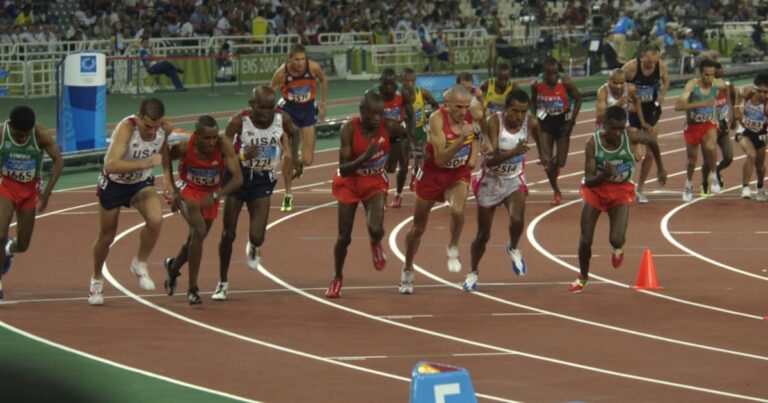Introduction
The 4×100 meter relay is one of the most thrilling and fast-paced events in track and field, often captivating audiences with its explosive speed and precise team coordination. This race, a staple of the Olympic Games, not only showcases individual speed but also emphasizes the importance of teamwork and seamless baton exchanges. In this post, we’ll delve into the history, rules, strategies, and key highlights of the 4×100 relay, offering insights into why it remains a fan favorite.
What is the 4×100 Relay?
The 4×100 meter relay is a track and field event where four athletes each run a 100-meter segment, passing a baton to their teammates in a designated exchange zone. The objective is simple: complete the race in the shortest time possible while ensuring a smooth baton handoff between runners.
History of the 4×100 Relay in the Olympics
The 4×100 meter relay has been a part of the Olympic Games since the 1912 Stockholm Olympics. It was introduced for both men and women, reflecting the event’s significant role in showcasing team dynamics and speed.
Men’s Relay: Over the years, the men’s 4×100 relay has seen dominant performances from countries like the USA, Jamaica, and Great Britain. Notably, the USA has set numerous world records, with the Jamaican team, led by sprinting legends such as Usain Bolt, making a significant impact in recent decades.
Women’s Relay: The women’s 4×100 relay also boasts a rich history, with the USA and Jamaica frequently at the forefront. Teams like the American squad featuring athletes such as Florence Griffith-Joyner and the Jamaican team with Shelly-Ann Fraser-Pryce have made remarkable contributions to the event’s legacy.
Rules and Regulations
Understanding the rules of the 4×100 relay is crucial for both participants and spectators. Here are the key regulations:
- Exchange Zones: The baton must be passed within a 20-meter exchange zone. Failure to do so results in disqualification.
- Baton Handoffs: The baton must be exchanged within the exchange zone, and runners must maintain their lane during the handoff.
- Lane Discipline: Runners are required to stay in their designated lanes throughout the race. Leaving the lane can lead to disqualification.
- Start and Finish: The race begins with a staggered start from a block. Each runner completes their 100-meter leg before handing the baton to the next teammate.
Strategies for Success
Success in the 4×100 meter relay depends on several key strategies:
- Smooth Baton Exchanges: Practicing baton handoffs is crucial. The timing and technique of the exchange can make or break a team’s performance.
- Optimal Running Order: Teams often strategize the running order to leverage the strengths of each athlete. Typically, the fastest runner might anchor the final leg to maximize the chance of a strong finish.
- Start and Acceleration: A strong start and rapid acceleration from the starting blocks set the tone for the race. Runners need explosive speed to gain an early advantage.
- Team Coordination: Synchronization between runners is essential. The ability to work as a cohesive unit can lead to a more efficient and faster race.
Memorable Moments in Olympic History
- Jamaica’s World Record: At the 2012 London Olympics, the Jamaican men’s team, featuring Usain Bolt, set a world record with a time of 36.84 seconds, demonstrating extraordinary speed and teamwork.
- USA’s Dominance: The USA women’s team has consistently performed well, with iconic moments such as their gold medal win at the 1984 Los Angeles Olympics, showcasing the depth of talent in American sprinting.
- Historic Disqualifications: The 2008 Beijing Olympics saw a dramatic disqualification of the USA men’s team due to a baton exchange error, highlighting the high stakes and pressure of the event.
Conclusion
The 4×100 meter relay is a dynamic and exciting event that combines individual sprinting prowess with the intricate art of baton passing. Its history, rules, and strategies make it a fascinating spectacle in the Olympic Games, capturing the essence of teamwork and speed. Whether you’re a seasoned track and field enthusiast or new to the sport, the 4×100 relay offers an exhilarating glimpse into the world of competitive athletics.
By understanding the nuances of this event and appreciating its rich history, fans can gain a deeper appreciation for the skill and dedication required to excel in the 4×100 meter relay.
Key Players and Their Contributions
Men’s Team:
- Jesse Owens: A legend of the 1936 Berlin Olympics, Owens helped secure gold for the USA in the 4×100 meter relay, setting a world record in the process. His performance was a key highlight of the Games and a symbol of American athletic excellence.
- Bob Hayes: Known as “Bullet Bob,” Hayes was a crucial part of the 1964 Tokyo Olympics team. His speed and powerful leg helped the USA secure gold with a time of 39.0 seconds.
- Carl Lewis: A dominant figure in track and field, Lewis was part of the 1984 Los Angeles Olympics team that won gold. His contributions were instrumental in the USA’s success during the 1980s.
- Maurice Greene: As a key member of the 2000 Sydney Olympics team, Greene’s performance was vital in securing gold for the USA, continuing the nation’s strong tradition in the relay event.
- Justin Gatlin: A prominent sprinter, Gatlin was part of the USA’s gold-winning team at the 2004 Athens Olympics. His speed and reliability in the relay made him a crucial asset.
Women’s Team:
- Wilma Rudolph: The “fastest woman in the world” of the 1960 Rome Olympics, Rudolph was part of the team that won gold in the 4×100 meter relay. Her performance was a major highlight of the Games.
- Florence Griffith-Joyner: Known for her speed and style, Griffith-Joyner was a key player in the 1988 Seoul Olympics team that set a world record with a time of 41.37 seconds.
- Allyson Felix: One of the most decorated athletes in the history of track and field, Felix has been part of multiple gold-winning teams, including the 2008 Beijing and 2012 London Olympics.
- Carmelita Jeter: Jeter played a crucial role in the 2011 World Championships and was a key member of the 2008 Beijing Olympics team, helping secure the gold medal for the USA.
USA’s Winning History
Men’s Relay:
- 1912 Stockholm Olympics: The USA team won gold with a time of 42.2 seconds, setting a precedent for future performances.
- 1964 Tokyo Olympics: The USA team, featuring Bob Hayes, won gold with a time of 39.0 seconds.
- 1984 Los Angeles Olympics: The American team, including Carl Lewis, won gold with a time of 37.83 seconds.
- 2000 Sydney Olympics: The USA team, with Maurice Greene, won gold with a time of 37.61 seconds.
- 2008 Beijing Olympics: The USA team, featuring Tyson Gay and Walter Dix, initially won gold but was later disqualified due to a baton exchange error.
- 2012 London Olympics: The USA team, including Justin Gatlin and Tyson Gay, secured gold with a time of 37.04 seconds, reclaiming the title after their disqualification in 2008.
Women’s Relay:
- 1960 Rome Olympics: The USA team, with Wilma Rudolph, won gold with a time of 44.4 seconds.
- 1984 Los Angeles Olympics: The American women’s team won gold with a time of 41.97 seconds.
- 1988 Seoul Olympics: The USA team, featuring Florence Griffith-Joyner, set a world record with a time of 41.37 seconds.
- 2008 Beijing Olympics: The USA women’s team, including Allyson Felix, won gold with a time of 41.98 seconds.
- 2012 London Olympics: The American women’s team won gold with a time of 40.82 seconds, continuing their dominance in the event.
Special Moments for the USA
- Jesse Owens’ Historic Victory (1936): Owens’ performance in the 1936 Berlin Olympics was not only a triumph for the USA but also a powerful statement against the racial prejudices of the time. His victory in the 4×100 meter relay was a symbol of athletic excellence and resilience.
- Florence Griffith-Joyner’s World Record (1988): Griffith-Joyner’s world record in the 4×100 meter relay at the 1988 Seoul Olympics remains unmatched, showcasing an extraordinary combination of speed and technique.
- The 2008 Beijing Olympics Controversy: The disqualification of the USA men’s team due to a baton exchange error was a dramatic and emotional moment. The team’s subsequent redemption with a gold medal win in 2012 highlighted their resilience and strength.
- Allyson Felix’s Record-Breaking Success: Felix’s achievements in the 4×100 meter relay, including her multiple gold medals, solidify her status as one of the greatest sprinters in Olympic history.
Conclusion
The 4×100 meter relay has been a stage for some of the most memorable moments in Olympic history, with the USA consistently showcasing remarkable talent and teamwork. From Jesse Owens’ historic victory to Allyson Felix’s record-breaking performances, the USA’s legacy in this event is a testament to the nation’s commitment to excellence in track and field. As fans continue to celebrate these incredible athletes and their achievements, the 4×100 meter relay remains a highlight of the Olympic Games, embodying the spirit of speed, precision, and national pride.
Best US Festivals and Events: Dates, Importance, and Celebrations







